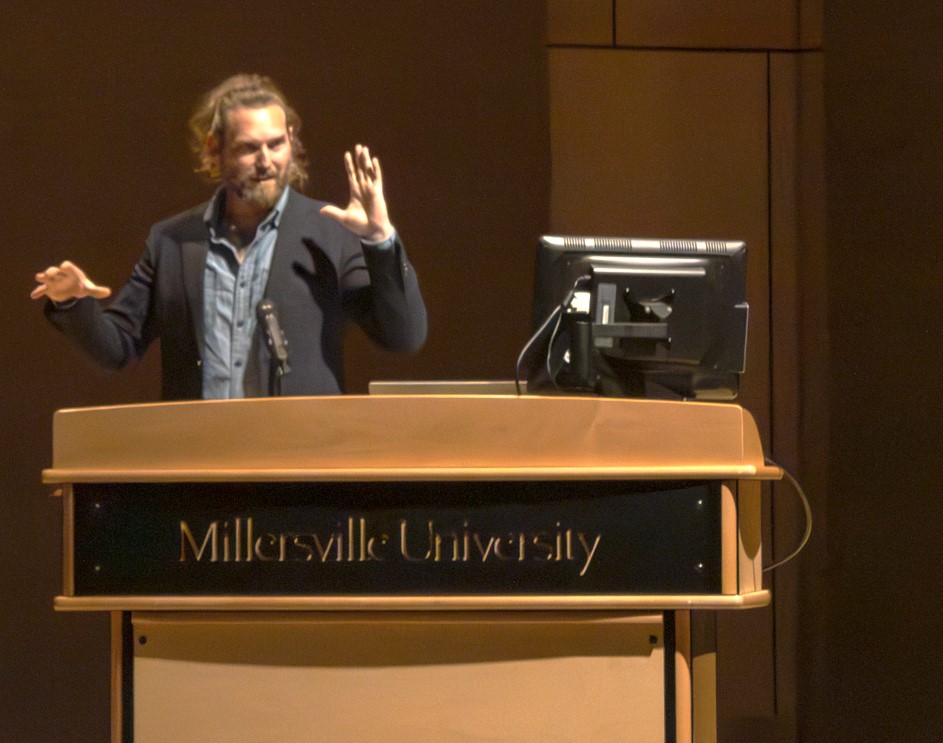Jesse Krimes, a Millersville University alumnus and internationally featured artist, gave the Conrad Nelson Endowed Fellowship lecture at Millersville University’s Winter Center Thursday evening.
Millersville University art professor Line Bruntse said Krimes is the first Millersville alumnus to be awarded the Conrad Nelson Artist-in-Residence Fellowship. His lecture focused on his experiences making art even in the oppressive, traumatic environment of federal prison. He served a six-year sentence for drug offenses and during that time produced art pieces on materials available to him, including bedsheets and prison-issued soap bars.

Krimes’ first artwork “Purgatory,” was produced while he was in solitary confinement. He transferred newspaper images of mugshots and celebrities onto soap bars and hid them inside of playing cards. The pieces were smuggled out of prison and were later displayed as a set of 292 images, still within their playing-card packaging. To cut open the cards, Krimes used the connector of an AAA battery, since cutting tools such as knives were prohibited in prison. “Purgatory,” is meant to call into question who is viewed as an “offender.”
“I very quickly realized that they could pretty much take literally everything from me. They removed me from society, from my family, took my clothes, my house, every societal thing that is a marker for who you are as a person.” He realized that the thing the prison system could not take from was his ability to create.
His second prison art series was created while he was in the federal penitentiary. “Apokaluptein:16389067,” the number being his federal prison identification number, consists of a room-sized expanse of prison bedsheets onto whatever images from the New York Times were transferred in using hair gel and plastic spoons.
The bedsheets were a symbol used to send a message about the prison labor system, which he said is an evolution of slavery. Prisoners work to produce military clothing, office furniture, solar panels and other products. Krimes said the wages were between seventy-five cents to a dollar per hour. These products can be sold in the consumer market, competing against other products.
“Apokaluptein:16389067” was produced in segments over three years, working twelve hours a day. Each segment was smuggled out of prison and shipped to a Millersville University professors for safekeeping. He also had guards who were sympathetic to his efforts and hid his work in a staff locker to hide them from other, less “sympathetic guards.” Both “Apokaluptein:16389067” and “Purgatory” are currently on display, as the “Corrections” exhibit until July 13 at the Metropolitan Museum of Art in New York City.
After Krimes left prison and became an established artist. He began programs for funding and supporting artists who had been impacted by the justice system. These programs became the Center for Art and Advocacy, which supports “justice-impacted” creatives through fellowship funding and other initiatives. One program currently being built by the Center is a residency program in Pennsylvania, aiming to provide justice-impacted artists with what Krimes calls a “mini-MFA” program.
“I think people are often very grateful…We are often the very first funder of our artists. Some of them have been homeless, living out of their car, in pretty dire situations and since receiving our grants they’ve gone on to have solo shows at the Brooklyn Museum, get McArthur Genius Fellowships, win Pulitzer Prizes and get Guggenheim Fellowships.”






